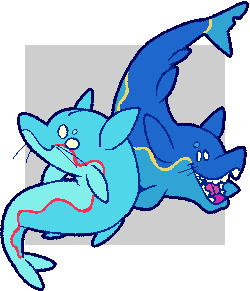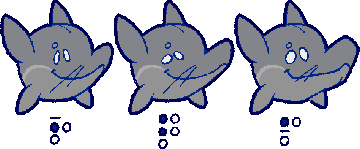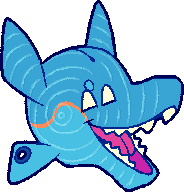Piscapiens
Pseudelphinus sapiens
 A feminine (left) and masculine (right) piscapien
A feminine (left) and masculine (right) piscapien- Origin planet: Kc-kc
- Diet class: Piscivore
- Size class: Medium
- Habitation: Aquatic
 Thriving
Thriving
Piscapiens are an aquatic space-faring sophont species of alien. They bear a superficial ressemblance to Earth's dolphins, though are closer physiologically to fish. They are an obligate piscivorous species. Their dominant colony (the colony that most piscapiens live in) is K'klek, which is also one of the largest importers of robotics. Robotic enhancements are very common in piscapien culture, particularly due to their lack of manipulatory limbs and the general limitations of aquatic life.
Anatomy & physiology
Piscapiens range from 1-1.4m (3.3-4.6ft) in length, with a rubbery skin adapted for fast movement in the water. They have seven fins; four upper and lower pectoral fins, 2 dorsal fins, and a caudal fin. Their tail fin and spine undulate in a side-to-side motion in order to propel themselves through water.
The head of the piscapien bears a large fatty mass wrapped in sensitive nerves, which helps them to detect minute movements underwater. This used to serve the important purpose of helping detect and hunt down prey. The area is very sensitive to touch.

tooth "clusters"
They have retractable gills which retract into a gill slit on the top of their heads. When on land, piscapiens produce a bubbly substance from their gill slit to keep it protected and moisturized, as well as allowing them to breathe on land longer.
They have pointed teeth, clustered into five bone "masses" consisting of a central tooth and two rows on the upper jaw, and two rows on the lower jaw. These tooth clusters are shed annually.
Piscapiens have two tongues, which allow them to make complex vocalizations. Series of clicks are very common in their languages, with the dual tongues helping to create rapid and simultaneous clicking. Tongues are also occasionally used to finely manipulate objects.
Sex & gender

Most piscapien cultures recognize three sexes. These sexes consist of a feminine sex, a masculine sex, and a "satellite" sex, which lies somewhat between the two. The feminine sex produces eggs, whilst the masculine sex and satellite sex produce sperm. About 10% of the population falls under the satellite sex classification, while the rest of the population is fairly equally split between feminine and masculine.
Besides internal reproductive anatomy, the sexes are often recognizable through physical differences in the face. The masculine sex has a more robust jaw and a longer snout, with shorter whiskers, while the feminine sex has a shorter and smoother snout with longer whiskers. The satellite sex lies between, with a long but smooth snout with longer whiskers.
Life cycle & reproduction
The feminine sex can be internally fertilized by a member of the masculine sex or by a satellite. Piscapiens are oviviparous, meaning they develop soft-shelled eggs in the womb which hatch inside the body. The egg remnants and the infant are expelled shortly after hatching. Piscapiens typically have only one baby at a time, outside of rare circumstances. Newborn piscapiens are capable of swimming immediately upon birth, but require parental care to feed and grow.
Diet
The natural diet of the piscapiens consists largely of aquatic livestock of their native planet, though lab-grown or printed meat substitutes and alien meats may be consumed as well. Due to this, they are considered to be piscivorous.
Biological variation

west sea, mid sea, east sea
In the K'klek culture, piscapiens divide themselves into three race groups; the west sea, mid sea, and east sea groups. The differences between these races is largely pigmentary, with very few genetic differences between races. The attitudes around these races varies depending on the individual and their subculture. The west sea race has the lightest and greenest skin tones, with a pinkish flank stripe, while the east sea race has the darkest and bluest skin tones, with a yellowish flank stripe. The mid sea race has a less clear definition, and covers skin tones between the two, with orangeish or reddish flank stripes.
Cleft chins are common in the masculine sex (though can occur among all sexes), and are a product of an incomplete fusion of the lower jaw bone.
Culture & society
The dominant culture in piscapien society is the widespread K'klek culture. This became the dominant culture of their planet following a disastrous global war. The war lead to an agreement to unionize the remaining cultures into a single global force. Many other cultures have arisen since space travel became the norm.
Most piscapien cultures are equivalent to partiarchal, with the masculine sex being viewed as the "stronger sex", though actual sex differences are very few. The satellite sex often has an important spiritual role, being often seen as a way to bridge the divide between the masculine and feminine sexes or other concepts such as light and dark, good and evil, etc.
Polygamy is very common across piscapien cultures. Those of the masculine sex will have many mates throughout their lifetime, consisting mostly of those of the feminine sex and occasionally satellites. These mates are often simultaneous, in groups called a harem. Though uncommon, in some cultures it is acceptable for those of the feminine sex or satellite sex to have their own harems. It is even possible for those of the masculine sex to have others of the masculine sex within their harems.

scarification and a fin tunnel
piercing.
Body modification is not uncommon, existing mostly in the form of whisker pulling and scarification. Whisker pulling is typically seen as masculine. Whiskers will gradually regrow and thus require frequent plucking. Since whiskers no longer have much of a purpose in foraging or navigation, removing them is not an issue. Scarification is the second most common form of body modification and is much more permanent, with scars often clustered around the head, jaw, and midpoint of the tail. Fin piercings, while less common, are also done.
